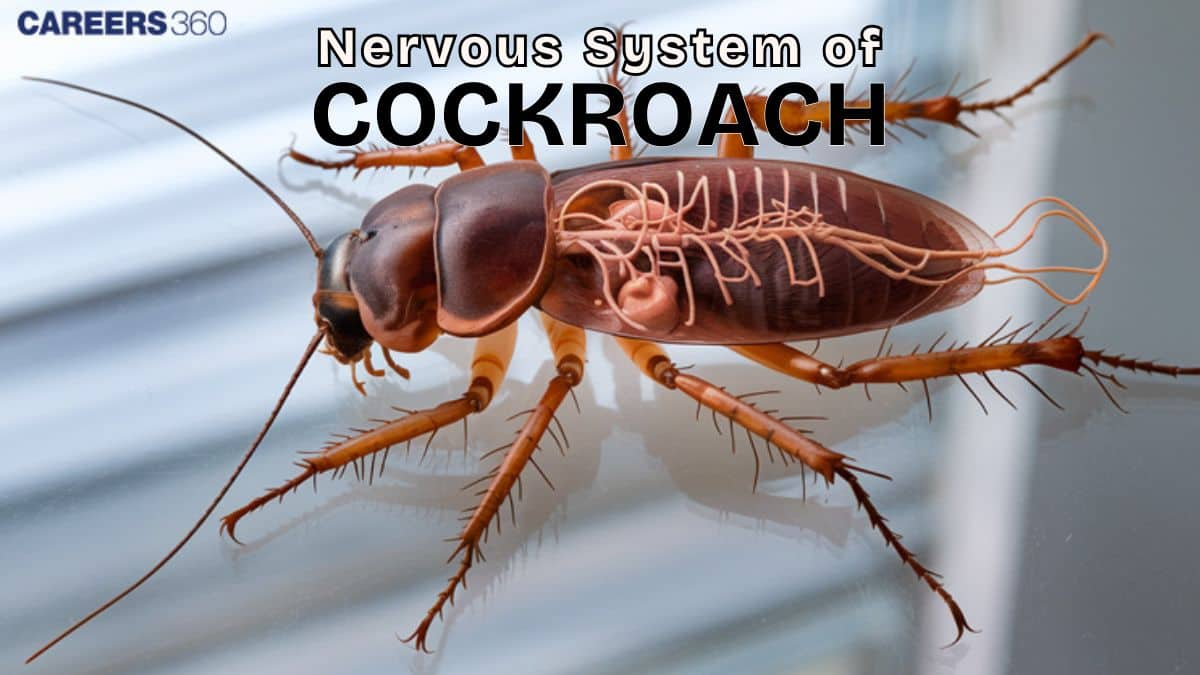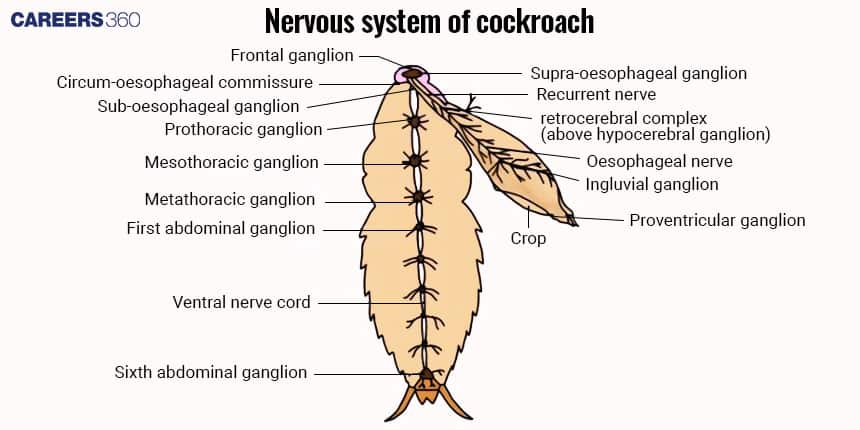Nervous System Of Cockroach
The cockroach nervous system consists of a central nervous system (brain, subesophageal ganglion, ventral nerve cord) and a peripheral nervous system. It processes sensory input, coordinates movements, and regulates behaviours like feeding, reflexes, and defense. Understanding this system is vital for NEET biology.
This Story also Contains
- Overview of Cockroach Nervous System
- Central Nervous System (CNS) in Cockroach
- Peripheral Nervous System (PNS)
- Sense Organs of Cockroach
- Neurotransmitters and Neural Pathways
- Functions and Behavioural Coordination
- Cockroach Nervous System NEET MCQs (With Answers & Explanations)

Overview of Cockroach Nervous System
The nervous system of a cockroach is a high-order organised structure that includes the central nervous system and the peripheral nervous system. The CNS consists of the brain and a series of ganglia connected by the ventral nerve cord, while the latter includes all the nerves ramifying from the CNS to the rest of the body. This complicated network would allow the cockroach to process sensory information and coordinate movement in an organised way.
The central nervous system acts as a control centre where information is processed, and various responses are then dictated, while the peripheral nervous system transmits signals to and from parts of the body. Together, they help the cockroach achieve complex behaviours, from simple reflex actions to sophisticated movements and environmental interactions.

Central Nervous System (CNS) in Cockroach
A cockroach's CNS includes a brain also referred to as the supraesophageal ganglion, subesophageal ganglion, and the ventral nerve cord.
Brain (Supraesophageal Ganglion)
Comprise of three fused ganglia.
Located in the head, above the oesophagus.
Responsible for processing sensory information from the eyes, antennae, and other sensory organs.
Controls higher-order functions like learning and memory.
Communicates with the subesophageal ganglion to control mouthparts and feeding behaviours.
Subesophageal Ganglion
Located below the oesophagus.
Comprising three fused ganglia.
Controls the muscles of the mouthparts and thus enables the insect to feed and manipulate food.
Coordinates with the brain to control many of the complex motor movements.
Ventral Nerve Cord
The ventral nerve cord extends the length of the cockroach's body, connecting the brain and subesophageal ganglion with the rest of the nervous system.
Composition And Segmentation
A double chain of ganglia that are segmentally arranged.
Most commonly, a single pair of ganglia in each body segment.
Ganglia And Their Functions
Each ganglion controls the movements and functions of its respective segment.
Ganglia mediate reflex actions and conduct localised processing of sensory information.
Connectivity Between Ganglia
Connected by paired longitudinal connectives.
Enables coordination between different segments, thus facilitating complex and coordinated movements.
Peripheral Nervous System (PNS)
The PNS includes nerves that extend from the CNS towards the cockroach's body and aid in communicating signals between the brain, ganglia, and peripheral organs.
Nerve Fibers
Composed of sensory (afferent) and motor (efferent) nerves.
Sensory nerves carry information from the sensory organs to the CNS.
Motor nerves carry signals from the CNS to muscles and glands.
Sensory And Motor Nerves
The sensory nerves perceive environmental stimuli including touch, temperature and chemicals.
Motor nerves control movements and actions by signalling to muscles.
Interaction With The CNS
Peripheral nerves send sensory input to the CNS for processing.
CNS sends back commands through motor nerves to execute responses and actions.
Sense Organs of Cockroach
Cockroaches have numerous sense organs and receptors which help them effectively interact with their environment.
Antennae
Have numerous sensory receptors.
They detect chemical, tactile, and thermal stimuli.
They aid navigation, finding food, and detecting predators.
Compound Eyes
Made of many ommatidia, individual visual units.
Provide a broad field of vision
Movement and basic shapes can be detected which helps in navigation and avoiding predators.
Tactile Receptors
Over the body with a high concentration on legs and antennae.
Senses touch and vibrations.
Allows the cockroach to feel its environment and avoid obstacles.
Neurotransmitters and Neural Pathways
Neurotransmitters are chemicals that transmit the signal across synapses between neurons. In the cockroach's case, it plays a crucial role in its nervous system.
Acetylcholine: Main neurotransmitter for neuromuscular junctions.
Dopamine and Serotonin: Involved in mood regulation and motor control.
Nerve pathways for multiple behaviors and responses:
Follow direct routes from sensory input to motor output.
Multiple neural circuits and neurotransmitter systems will be involved in coordination and execution.
Functions and Behavioural Coordination
The cockroach nervous system is sustained along with a host of functions and behaviours crucial for survival.
Reflex Actions
Very fast, involuntary responses to stimuli.
Controlled by the ventral nerve cord ganglia.
Locomotion
It involves the exact controlling of the leg and wing muscles.
CNS integrates sensory information to coordinate complex movements
Feeding Behaviour
This is controlled by the subesophageal ganglion.
The process involves the sensory detection of food and the coordination of mouthpart movements
Defensive Responses
These are triggered by sensory input from antennae and eyes.
Fast escape movements are controlled by CNS and PNS.
Cockroach Nervous System NEET MCQs (With Answers & Explanations)
Important topics for NEET exam are:
Structure of Circulatory System
Comparison between Human and Cockroach circulatory system
Practice Questions for NEET
Q1. How many ganglia are present in the thorax and abdomen of the cockroach respectively?
6 and 3
3 and 6
3 and 7
None of these
Correct answer: 2) 3 and 6
Explanation:
Three ganglia lie in the thorax and six in the abdomen of the cockroach. These ganglia act as control centers, directing the movement and activity of the cockroach body. The thoracic ganglia primarily control leg and wing movement, whereas the abdominal ganglia regulate digestion, excretion, and reproductive processes.
Hence, the correct answer is option 2) 3 and 6.
Q2. What series of ganglia joined in the nervous system of a cockroach?
Paired lateral connectives
Single longitudinal connective
Paired longitudinal connective
Single horizontal connective
Correct answer: 3) Paired longitudinal connective
Explanation:
The cockroach's nervous system is distributed throughout the body. The cockroach's nervous system is composed of several fused and segmentally arranged ganglia. It is connected on the ventral side by paired longitudinal connectives. The cockroach's nervous system is distributed throughout the body. The cockroach's nervous system is composed of several fused and segmentally arranged ganglia. It is connected on the ventral side by paired longitudinal connectives. The brain, located in the head, primarily controls sensory functions and complex behaviours. However, the segmental ganglia control most of the reflexes and movements independently. This decentralized organization allows a cockroach to continue moving even if its head is removed. The ventral nerve cord ensures efficient communication between the ganglia, coordinating the cockroach's locomotion and survival responses.
Hence, the correct answer is option 3) paired longitudinal connective
Q3. The vision of the cockroach is
Mosaic
Having more resolution
Diurnal
Superposition
Correct answer: 1) Mosaic
Explanation:
Vision in Insects -
There are two types of vision in insects -
mosaic vision (apposition image) during daytime and
superposition (dull image) in dim light.
If the pigmented iris sheath is removed from the compound eye of insects, only a superposition image will be formed.
Hence, the correct answer is option 1)Mosaic.
Also Read:
Frequently Asked Questions (FAQs)
The processing of sensory information occurs in the brain and is then distributed through the CNS and PNS to elicit appropriate responses.
The brain, more commonly called the supraesophageal ganglion, processes sensory information and coordinates complex behaviours.
Cockroaches detect danger with their antennae and have nervous system-controlled quick escape reflexes.
Antennae are major sense organs that perceive the environment and detect chemical signals as well as physical things around them.
Movement is coordinated through the ventral nerve cord and segmental ganglia controlling the legs and wings.